management of IBM : case study of IBM
VerifiedAdded on 2022/01/17
|6
|1811
|59
AI Summary
Contribute Materials
Your contribution can guide someone’s learning journey. Share your
documents today.
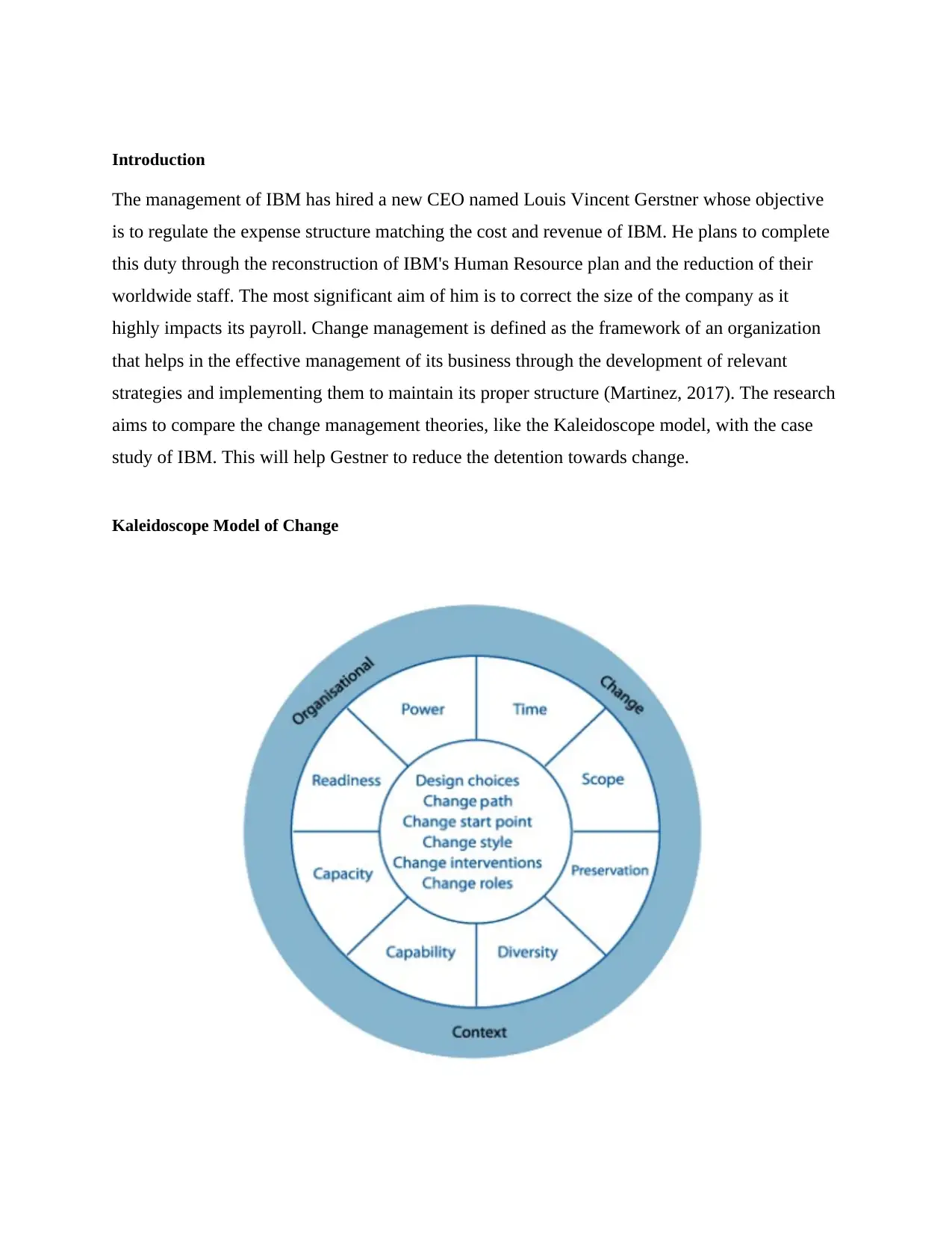
Introduction
The management of IBM has hired a new CEO named Louis Vincent Gerstner whose objective
is to regulate the expense structure matching the cost and revenue of IBM. He plans to complete
this duty through the reconstruction of IBM's Human Resource plan and the reduction of their
worldwide staff. The most significant aim of him is to correct the size of the company as it
highly impacts its payroll. Change management is defined as the framework of an organization
that helps in the effective management of its business through the development of relevant
strategies and implementing them to maintain its proper structure (Martinez, 2017). The research
aims to compare the change management theories, like the Kaleidoscope model, with the case
study of IBM. This will help Gestner to reduce the detention towards change.
Kaleidoscope Model of Change
The management of IBM has hired a new CEO named Louis Vincent Gerstner whose objective
is to regulate the expense structure matching the cost and revenue of IBM. He plans to complete
this duty through the reconstruction of IBM's Human Resource plan and the reduction of their
worldwide staff. The most significant aim of him is to correct the size of the company as it
highly impacts its payroll. Change management is defined as the framework of an organization
that helps in the effective management of its business through the development of relevant
strategies and implementing them to maintain its proper structure (Martinez, 2017). The research
aims to compare the change management theories, like the Kaleidoscope model, with the case
study of IBM. This will help Gestner to reduce the detention towards change.
Kaleidoscope Model of Change
Secure Best Marks with AI Grader
Need help grading? Try our AI Grader for instant feedback on your assignments.
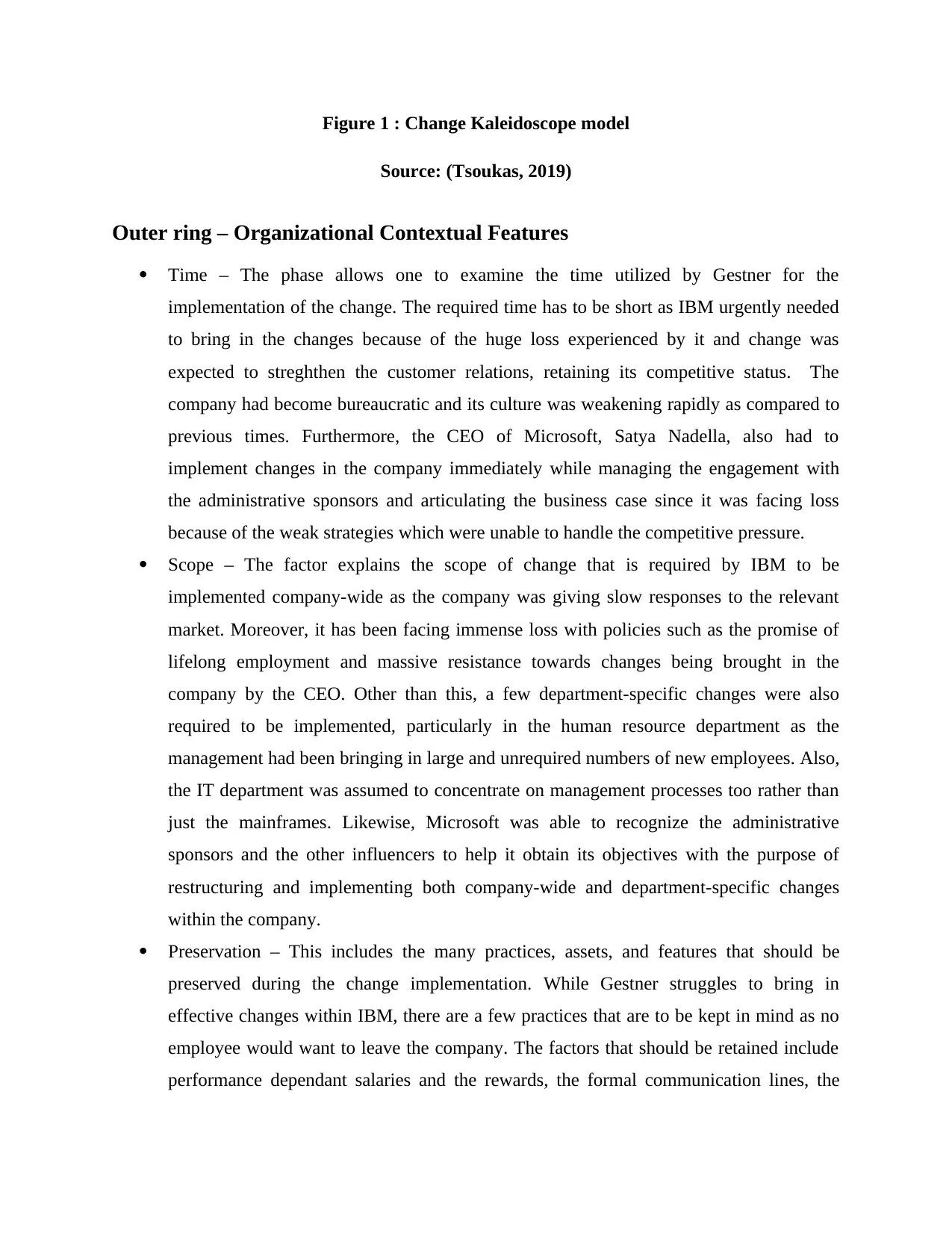
Figure 1 : Change Kaleidoscope model
Source: (Tsoukas, 2019)
Outer ring – Organizational Contextual Features
Time – The phase allows one to examine the time utilized by Gestner for the
implementation of the change. The required time has to be short as IBM urgently needed
to bring in the changes because of the huge loss experienced by it and change was
expected to streghthen the customer relations, retaining its competitive status. The
company had become bureaucratic and its culture was weakening rapidly as compared to
previous times. Furthermore, the CEO of Microsoft, Satya Nadella, also had to
implement changes in the company immediately while managing the engagement with
the administrative sponsors and articulating the business case since it was facing loss
because of the weak strategies which were unable to handle the competitive pressure.
Scope – The factor explains the scope of change that is required by IBM to be
implemented company-wide as the company was giving slow responses to the relevant
market. Moreover, it has been facing immense loss with policies such as the promise of
lifelong employment and massive resistance towards changes being brought in the
company by the CEO. Other than this, a few department-specific changes were also
required to be implemented, particularly in the human resource department as the
management had been bringing in large and unrequired numbers of new employees. Also,
the IT department was assumed to concentrate on management processes too rather than
just the mainframes. Likewise, Microsoft was able to recognize the administrative
sponsors and the other influencers to help it obtain its objectives with the purpose of
restructuring and implementing both company-wide and department-specific changes
within the company.
Preservation – This includes the many practices, assets, and features that should be
preserved during the change implementation. While Gestner struggles to bring in
effective changes within IBM, there are a few practices that are to be kept in mind as no
employee would want to leave the company. The factors that should be retained include
performance dependant salaries and the rewards, the formal communication lines, the
Source: (Tsoukas, 2019)
Outer ring – Organizational Contextual Features
Time – The phase allows one to examine the time utilized by Gestner for the
implementation of the change. The required time has to be short as IBM urgently needed
to bring in the changes because of the huge loss experienced by it and change was
expected to streghthen the customer relations, retaining its competitive status. The
company had become bureaucratic and its culture was weakening rapidly as compared to
previous times. Furthermore, the CEO of Microsoft, Satya Nadella, also had to
implement changes in the company immediately while managing the engagement with
the administrative sponsors and articulating the business case since it was facing loss
because of the weak strategies which were unable to handle the competitive pressure.
Scope – The factor explains the scope of change that is required by IBM to be
implemented company-wide as the company was giving slow responses to the relevant
market. Moreover, it has been facing immense loss with policies such as the promise of
lifelong employment and massive resistance towards changes being brought in the
company by the CEO. Other than this, a few department-specific changes were also
required to be implemented, particularly in the human resource department as the
management had been bringing in large and unrequired numbers of new employees. Also,
the IT department was assumed to concentrate on management processes too rather than
just the mainframes. Likewise, Microsoft was able to recognize the administrative
sponsors and the other influencers to help it obtain its objectives with the purpose of
restructuring and implementing both company-wide and department-specific changes
within the company.
Preservation – This includes the many practices, assets, and features that should be
preserved during the change implementation. While Gestner struggles to bring in
effective changes within IBM, there are a few practices that are to be kept in mind as no
employee would want to leave the company. The factors that should be retained include
performance dependant salaries and the rewards, the formal communication lines, the
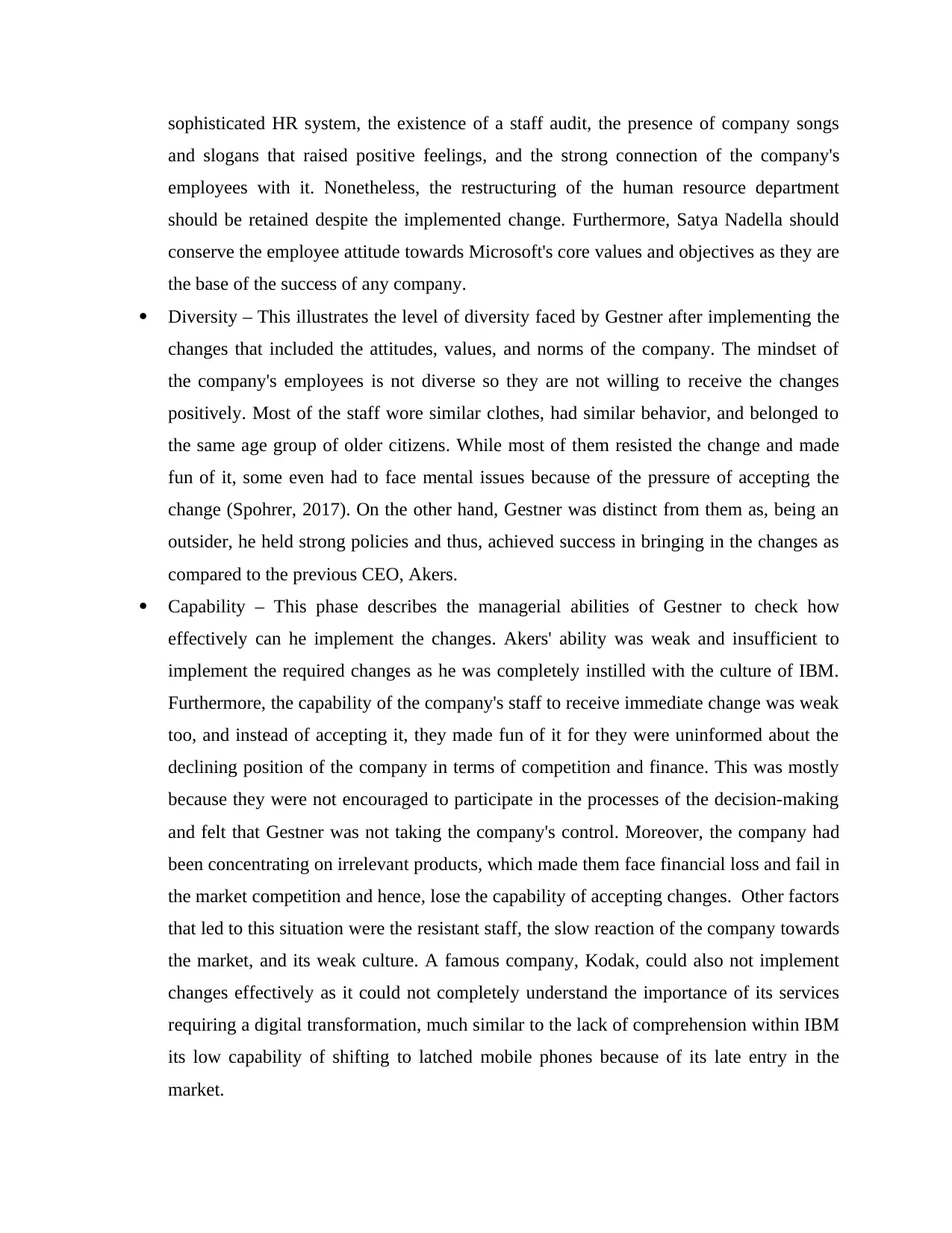
sophisticated HR system, the existence of a staff audit, the presence of company songs
and slogans that raised positive feelings, and the strong connection of the company's
employees with it. Nonetheless, the restructuring of the human resource department
should be retained despite the implemented change. Furthermore, Satya Nadella should
conserve the employee attitude towards Microsoft's core values and objectives as they are
the base of the success of any company.
Diversity – This illustrates the level of diversity faced by Gestner after implementing the
changes that included the attitudes, values, and norms of the company. The mindset of
the company's employees is not diverse so they are not willing to receive the changes
positively. Most of the staff wore similar clothes, had similar behavior, and belonged to
the same age group of older citizens. While most of them resisted the change and made
fun of it, some even had to face mental issues because of the pressure of accepting the
change (Spohrer, 2017). On the other hand, Gestner was distinct from them as, being an
outsider, he held strong policies and thus, achieved success in bringing in the changes as
compared to the previous CEO, Akers.
Capability – This phase describes the managerial abilities of Gestner to check how
effectively can he implement the changes. Akers' ability was weak and insufficient to
implement the required changes as he was completely instilled with the culture of IBM.
Furthermore, the capability of the company's staff to receive immediate change was weak
too, and instead of accepting it, they made fun of it for they were uninformed about the
declining position of the company in terms of competition and finance. This was mostly
because they were not encouraged to participate in the processes of the decision-making
and felt that Gestner was not taking the company's control. Moreover, the company had
been concentrating on irrelevant products, which made them face financial loss and fail in
the market competition and hence, lose the capability of accepting changes. Other factors
that led to this situation were the resistant staff, the slow reaction of the company towards
the market, and its weak culture. A famous company, Kodak, could also not implement
changes effectively as it could not completely understand the importance of its services
requiring a digital transformation, much similar to the lack of comprehension within IBM
its low capability of shifting to latched mobile phones because of its late entry in the
market.
and slogans that raised positive feelings, and the strong connection of the company's
employees with it. Nonetheless, the restructuring of the human resource department
should be retained despite the implemented change. Furthermore, Satya Nadella should
conserve the employee attitude towards Microsoft's core values and objectives as they are
the base of the success of any company.
Diversity – This illustrates the level of diversity faced by Gestner after implementing the
changes that included the attitudes, values, and norms of the company. The mindset of
the company's employees is not diverse so they are not willing to receive the changes
positively. Most of the staff wore similar clothes, had similar behavior, and belonged to
the same age group of older citizens. While most of them resisted the change and made
fun of it, some even had to face mental issues because of the pressure of accepting the
change (Spohrer, 2017). On the other hand, Gestner was distinct from them as, being an
outsider, he held strong policies and thus, achieved success in bringing in the changes as
compared to the previous CEO, Akers.
Capability – This phase describes the managerial abilities of Gestner to check how
effectively can he implement the changes. Akers' ability was weak and insufficient to
implement the required changes as he was completely instilled with the culture of IBM.
Furthermore, the capability of the company's staff to receive immediate change was weak
too, and instead of accepting it, they made fun of it for they were uninformed about the
declining position of the company in terms of competition and finance. This was mostly
because they were not encouraged to participate in the processes of the decision-making
and felt that Gestner was not taking the company's control. Moreover, the company had
been concentrating on irrelevant products, which made them face financial loss and fail in
the market competition and hence, lose the capability of accepting changes. Other factors
that led to this situation were the resistant staff, the slow reaction of the company towards
the market, and its weak culture. A famous company, Kodak, could also not implement
changes effectively as it could not completely understand the importance of its services
requiring a digital transformation, much similar to the lack of comprehension within IBM
its low capability of shifting to latched mobile phones because of its late entry in the
market.
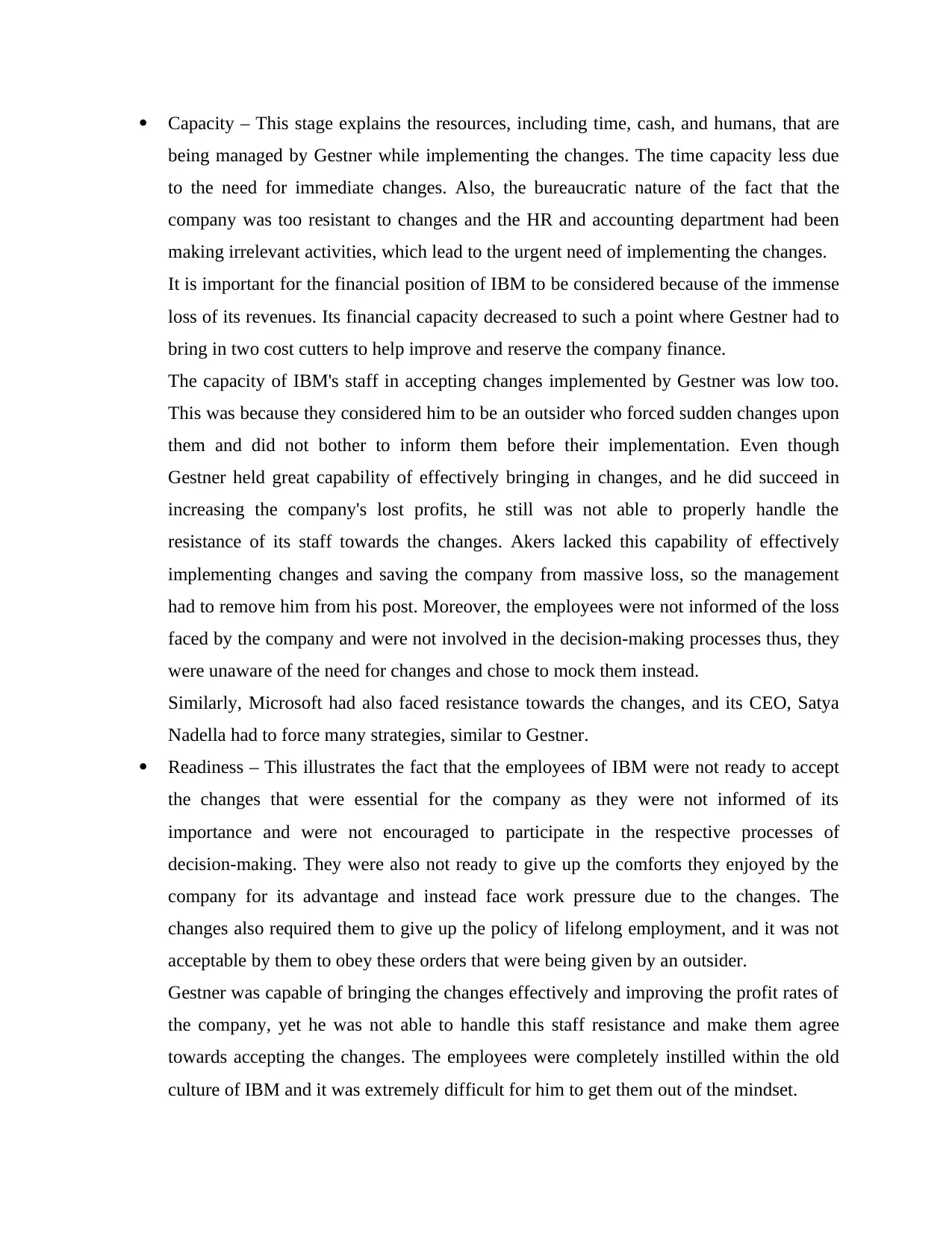
Capacity – This stage explains the resources, including time, cash, and humans, that are
being managed by Gestner while implementing the changes. The time capacity less due
to the need for immediate changes. Also, the bureaucratic nature of the fact that the
company was too resistant to changes and the HR and accounting department had been
making irrelevant activities, which lead to the urgent need of implementing the changes.
It is important for the financial position of IBM to be considered because of the immense
loss of its revenues. Its financial capacity decreased to such a point where Gestner had to
bring in two cost cutters to help improve and reserve the company finance.
The capacity of IBM's staff in accepting changes implemented by Gestner was low too.
This was because they considered him to be an outsider who forced sudden changes upon
them and did not bother to inform them before their implementation. Even though
Gestner held great capability of effectively bringing in changes, and he did succeed in
increasing the company's lost profits, he still was not able to properly handle the
resistance of its staff towards the changes. Akers lacked this capability of effectively
implementing changes and saving the company from massive loss, so the management
had to remove him from his post. Moreover, the employees were not informed of the loss
faced by the company and were not involved in the decision-making processes thus, they
were unaware of the need for changes and chose to mock them instead.
Similarly, Microsoft had also faced resistance towards the changes, and its CEO, Satya
Nadella had to force many strategies, similar to Gestner.
Readiness – This illustrates the fact that the employees of IBM were not ready to accept
the changes that were essential for the company as they were not informed of its
importance and were not encouraged to participate in the respective processes of
decision-making. They were also not ready to give up the comforts they enjoyed by the
company for its advantage and instead face work pressure due to the changes. The
changes also required them to give up the policy of lifelong employment, and it was not
acceptable by them to obey these orders that were being given by an outsider.
Gestner was capable of bringing the changes effectively and improving the profit rates of
the company, yet he was not able to handle this staff resistance and make them agree
towards accepting the changes. The employees were completely instilled within the old
culture of IBM and it was extremely difficult for him to get them out of the mindset.
being managed by Gestner while implementing the changes. The time capacity less due
to the need for immediate changes. Also, the bureaucratic nature of the fact that the
company was too resistant to changes and the HR and accounting department had been
making irrelevant activities, which lead to the urgent need of implementing the changes.
It is important for the financial position of IBM to be considered because of the immense
loss of its revenues. Its financial capacity decreased to such a point where Gestner had to
bring in two cost cutters to help improve and reserve the company finance.
The capacity of IBM's staff in accepting changes implemented by Gestner was low too.
This was because they considered him to be an outsider who forced sudden changes upon
them and did not bother to inform them before their implementation. Even though
Gestner held great capability of effectively bringing in changes, and he did succeed in
increasing the company's lost profits, he still was not able to properly handle the
resistance of its staff towards the changes. Akers lacked this capability of effectively
implementing changes and saving the company from massive loss, so the management
had to remove him from his post. Moreover, the employees were not informed of the loss
faced by the company and were not involved in the decision-making processes thus, they
were unaware of the need for changes and chose to mock them instead.
Similarly, Microsoft had also faced resistance towards the changes, and its CEO, Satya
Nadella had to force many strategies, similar to Gestner.
Readiness – This illustrates the fact that the employees of IBM were not ready to accept
the changes that were essential for the company as they were not informed of its
importance and were not encouraged to participate in the respective processes of
decision-making. They were also not ready to give up the comforts they enjoyed by the
company for its advantage and instead face work pressure due to the changes. The
changes also required them to give up the policy of lifelong employment, and it was not
acceptable by them to obey these orders that were being given by an outsider.
Gestner was capable of bringing the changes effectively and improving the profit rates of
the company, yet he was not able to handle this staff resistance and make them agree
towards accepting the changes. The employees were completely instilled within the old
culture of IBM and it was extremely difficult for him to get them out of the mindset.
Secure Best Marks with AI Grader
Need help grading? Try our AI Grader for instant feedback on your assignments.
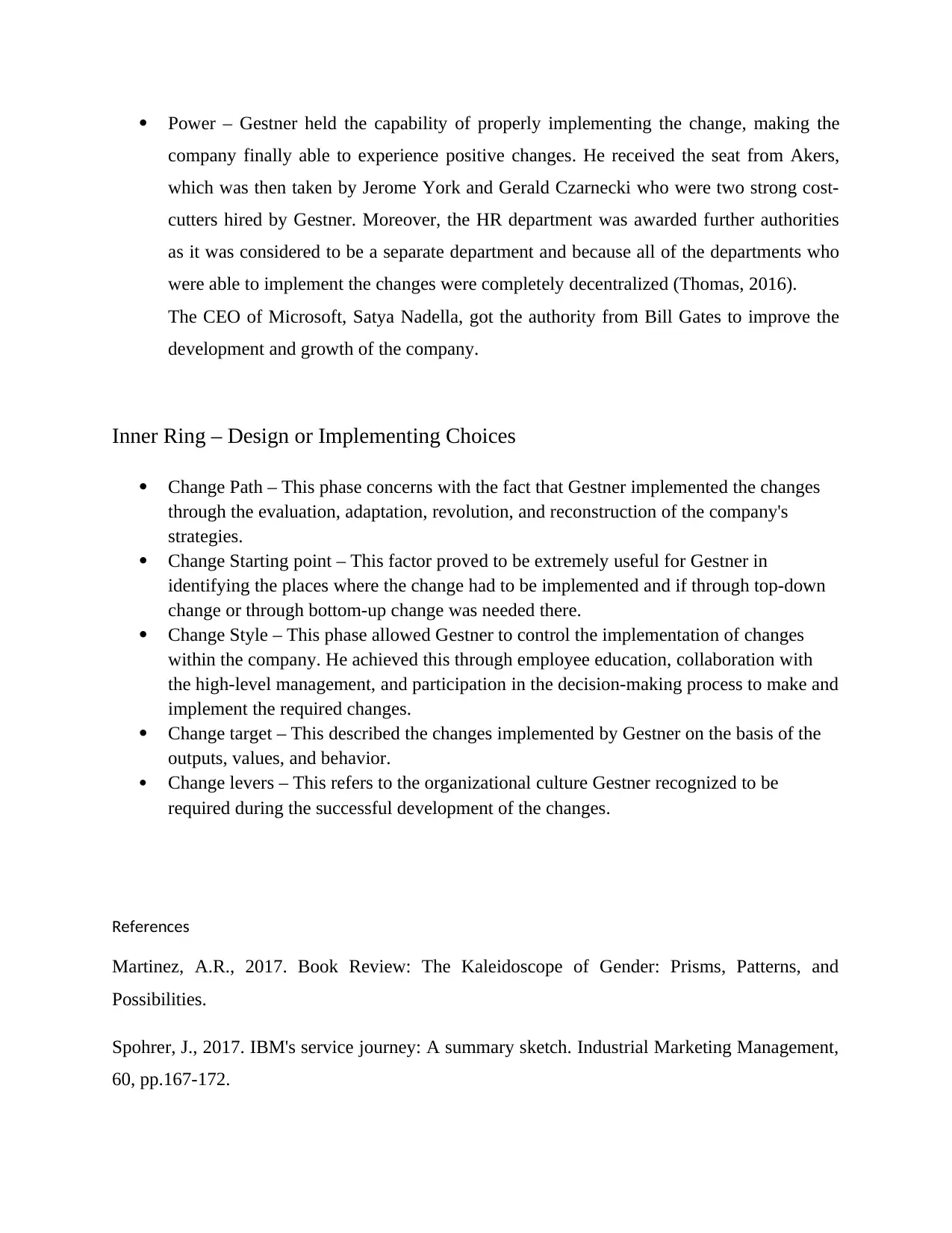
Power – Gestner held the capability of properly implementing the change, making the
company finally able to experience positive changes. He received the seat from Akers,
which was then taken by Jerome York and Gerald Czarnecki who were two strong cost-
cutters hired by Gestner. Moreover, the HR department was awarded further authorities
as it was considered to be a separate department and because all of the departments who
were able to implement the changes were completely decentralized (Thomas, 2016).
The CEO of Microsoft, Satya Nadella, got the authority from Bill Gates to improve the
development and growth of the company.
Inner Ring – Design or Implementing Choices
Change Path – This phase concerns with the fact that Gestner implemented the changes
through the evaluation, adaptation, revolution, and reconstruction of the company's
strategies.
Change Starting point – This factor proved to be extremely useful for Gestner in
identifying the places where the change had to be implemented and if through top-down
change or through bottom-up change was needed there.
Change Style – This phase allowed Gestner to control the implementation of changes
within the company. He achieved this through employee education, collaboration with
the high-level management, and participation in the decision-making process to make and
implement the required changes.
Change target – This described the changes implemented by Gestner on the basis of the
outputs, values, and behavior.
Change levers – This refers to the organizational culture Gestner recognized to be
required during the successful development of the changes.
References
Martinez, A.R., 2017. Book Review: The Kaleidoscope of Gender: Prisms, Patterns, and
Possibilities.
Spohrer, J., 2017. IBM's service journey: A summary sketch. Industrial Marketing Management,
60, pp.167-172.
company finally able to experience positive changes. He received the seat from Akers,
which was then taken by Jerome York and Gerald Czarnecki who were two strong cost-
cutters hired by Gestner. Moreover, the HR department was awarded further authorities
as it was considered to be a separate department and because all of the departments who
were able to implement the changes were completely decentralized (Thomas, 2016).
The CEO of Microsoft, Satya Nadella, got the authority from Bill Gates to improve the
development and growth of the company.
Inner Ring – Design or Implementing Choices
Change Path – This phase concerns with the fact that Gestner implemented the changes
through the evaluation, adaptation, revolution, and reconstruction of the company's
strategies.
Change Starting point – This factor proved to be extremely useful for Gestner in
identifying the places where the change had to be implemented and if through top-down
change or through bottom-up change was needed there.
Change Style – This phase allowed Gestner to control the implementation of changes
within the company. He achieved this through employee education, collaboration with
the high-level management, and participation in the decision-making process to make and
implement the required changes.
Change target – This described the changes implemented by Gestner on the basis of the
outputs, values, and behavior.
Change levers – This refers to the organizational culture Gestner recognized to be
required during the successful development of the changes.
References
Martinez, A.R., 2017. Book Review: The Kaleidoscope of Gender: Prisms, Patterns, and
Possibilities.
Spohrer, J., 2017. IBM's service journey: A summary sketch. Industrial Marketing Management,
60, pp.167-172.
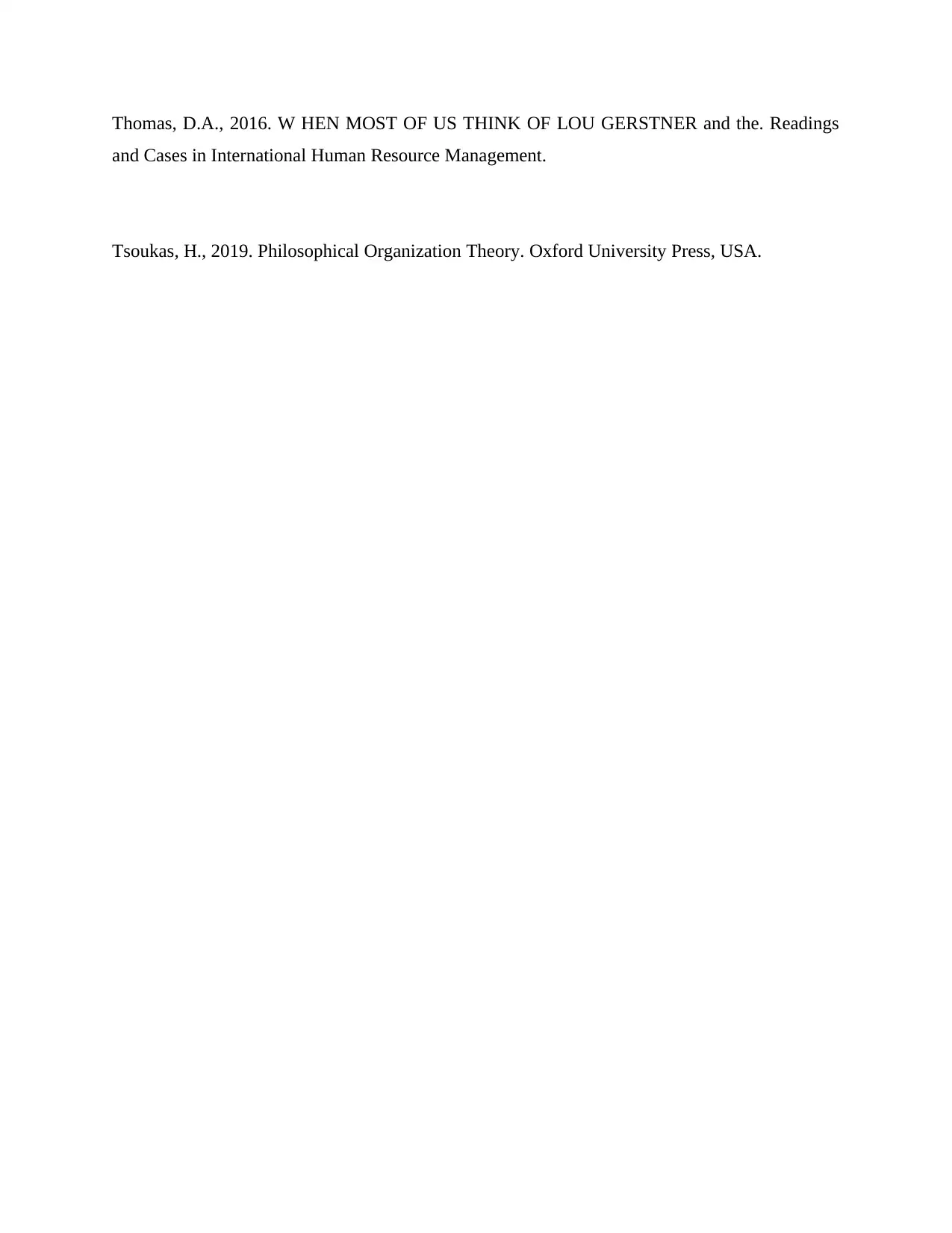
Thomas, D.A., 2016. W HEN MOST OF US THINK OF LOU GERSTNER and the. Readings
and Cases in International Human Resource Management.
Tsoukas, H., 2019. Philosophical Organization Theory. Oxford University Press, USA.
and Cases in International Human Resource Management.
Tsoukas, H., 2019. Philosophical Organization Theory. Oxford University Press, USA.
1 out of 6
Related Documents
Your All-in-One AI-Powered Toolkit for Academic Success.
+13062052269
info@desklib.com
Available 24*7 on WhatsApp / Email
![[object Object]](/_next/static/media/star-bottom.7253800d.svg)
Unlock your academic potential
© 2024 | Zucol Services PVT LTD | All rights reserved.




